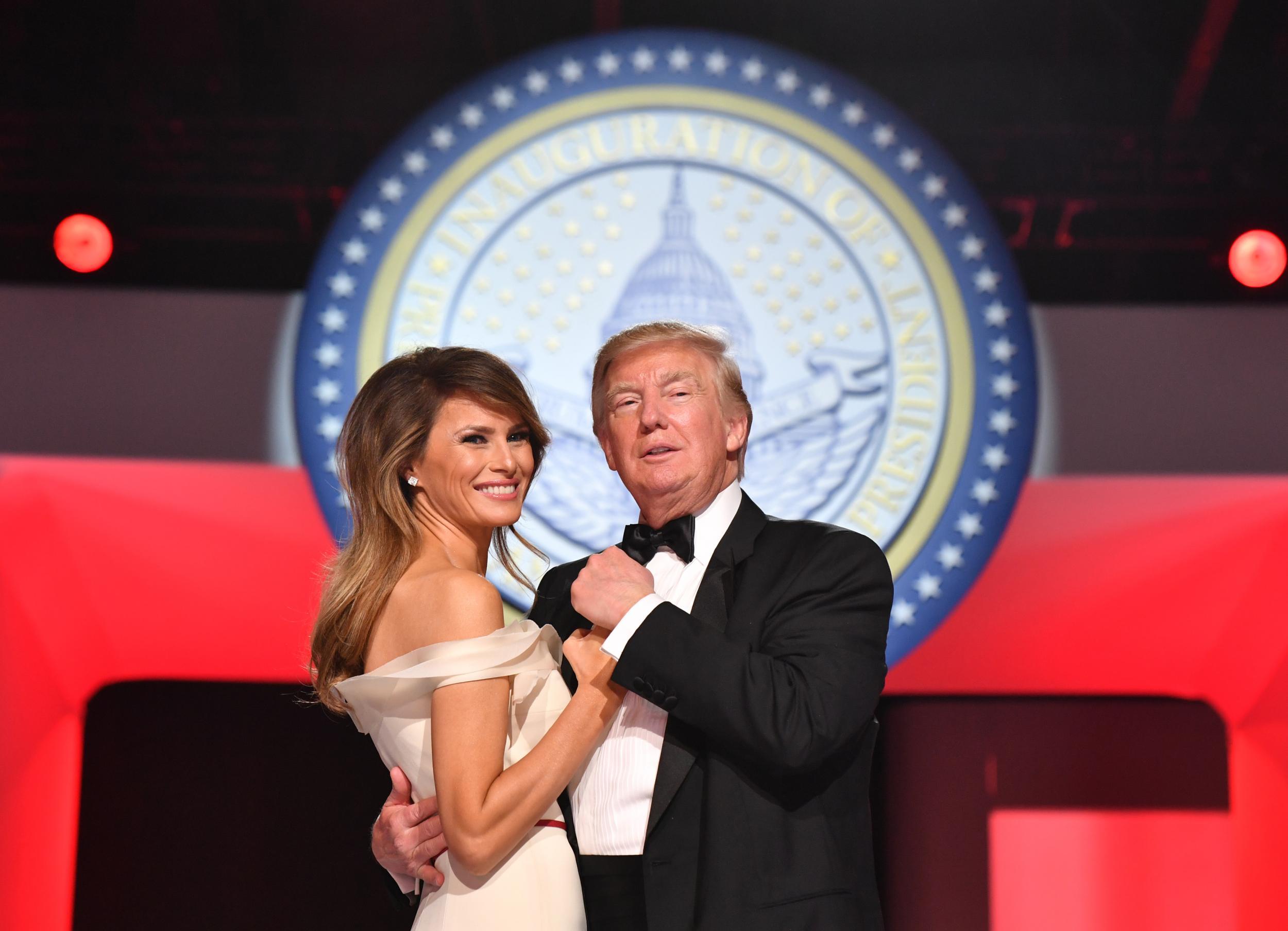The inauguration and a crowd size row
In the first instalment of our new series looking back at Trump’s presidency, Joe Sommerlad revisits the cold January morning where it all began


Donald Trump began his tenure as the 45th president of the United States on Friday 20 January 2017, when a disappointingly sparse crowd of well-wishers congregated on the National Mall in Washington DC to witness his inauguration in front of the US Capitol.
Trump commenced his one and only term in the White House as he meant to go on: by disputing factual reality and denouncing anyone who refused to accept his version of events.
The Manhattan luxury real estate magnate and star of NBC’s The Apprentice had been a familiar figure in American public life since the mid-1970s, a subject of tabloid fascination who came to embody the brash “greed is good” mantra espoused by Gordon Gekko in Oliver Stone’s Wall Street (1987). A New Yorker as recognisable as the Statue of Liberty, Trump was celebrated for his modern Midas lifestyle of trophy wives, anything-goes parties, private jets and looming skyscrapers, each of which carried his surname in showy gilt lettering.
“You’ve got to put your name on stuff or no one remembers you,” he would later advise French president Emmanuel Macron when the pair toured George Washington’s Virginia plantation estate Mount Vernon in April 2018, pointing out the Founding Father’s lamentable lack of commercial foresight.
Trump’s Eighties celebrity was brilliantly sent up by Brett Easton Ellis in American Psycho (1991), whose protagonist – homicidal investment banker Patrick Bateman – idolises the property titan.
But his supposedly unwavering instinct for opportunity had failed him - bigly - in the intervening years, leading to bankruptcy and humiliation when his Atlantic City casino enterprises collapsed.
Trump’s brand was only salvaged when Apprentice producer Mark Burnett dusted him down and ran a comb through that unmistakable blond hair in 2003.
The reality show – which found Trump setting routine business tasks for aspiring entrepreneurs before exclaiming “You’re fired!” at the least worthy – revitalised his public image over the course of its 14-season run.
The glorious vision of no-nonsense corporate success it projected would prove so enticing to viewers that Trump eventually found himself tipped for the presidency, a flattering notion that he cheerily courted before finally announcing his candidacy on 16 June 2015.
Descending the gold escalators at Trump Tower with wife Melania by his side, Trump told the world flatly “the American Dream is dead”, accused impoverished Mexican immigrants of being career criminals and rapists and promised a giant southern border wall to keep them out.
Written off from the start by the pundit class, Trump nevertheless tore through the competition in the primaries, exciting the electorate by trashing the likes of Ted Cruz, Marco Rubio, Lindsey Graham and Jeb Bush on the debate stage, tossing aside the etiquette guide and drawing whoops of glee by pledging to “drain the swamp” in DC.
No tactic was too low for the insurgent disrupter. He even tweeted an unflattering photograph of Cruz’s wife Heidi alongside one of Melania with the caption: “A picture is worth a thousand words.”
Encouraged by Rupert Murdoch’s Fox News, conservatives lapped up the live stage version of his online trolling act – Trump presenting himself as part insult comic, part showboating wrestler calling out an opponent – but the Democrats fatally underestimated his appeal to the neglected.
Their candidate, Hillary Clinton, betrayed herself and arguably turned off millions of voters when she complacently dismissed his admirers as a “basket of deplorables” at a September fundraising event.
The glorious vision of no-nonsense corporate success ‘The Apprentice’ projected would prove so enticing to viewers that Trump eventually found himself tipped for the presidency
Not even the notorious Access Hollywood tape – in which he was heard joking about sexually assaulting women in a 2005 interview with Billy Bush that surfaced just a month before election day – could derail the Trump train.
After a 10-week transition period in which the outgoing Barack and Michelle Obama had swallowed hard and behaved as obligingly as possible – a gesture Donald and Melania would not repeat for the Bidens four years later – here he was, stood in a long winter coat and trademark red tie, swearing the oath of office with the eyes of the world upon him.
He did so with his left hand resting upon the Bible, as is customary, and not on a copy of The Art of the Deal, as ex-aide Omarosa Manigault Newman recently told the BBC he had proposed.
The president’s inauguration speech began: “Today, we are not merely transferring power from one administration to another, or from one party to another, but we are transferring power from Washington, DC, and giving it back to you, the people.”
To many, his phrasing rang oddly familiar.
It was. He had lifted it wholesale from Tom Hardy’s Batman villain, Bane, in Christopher Nolan’s blockbuster The Dark Knight Rises (2012), the character an anarcho-terrorist who wields phoney populism to incite revolution.
Trump, incidentally, would again be accused of infringing on Warner Bros’s copyright over the same movie in April 2019 when he used a portion of Hans Zimmer’s stirring orchestral score for a campaign promo without authorisation. It would be a problem he would run into again when seeking re-election as everyone from Neil Young to the Village People rebuked him for using their anthems without permission at his rallies.
The rest of the address echoed his candidacy announcement in painting a dystopian picture of post-industrial decline in America, blaming globalisation for taking jobs overseas and – borrowing the parlance of the Great Depression – leaving the “forgotten men and women” of the heartland bereft while a selfish elite enriched itself, apparently pardoning himself of the charge.
He spoke of eradicating “the crime and gangs and drugs that have stolen too many lives and robbed our country of so much unrealised potential” and declared emphatically: “This American carnage stops right here and stops right now.”
Those words were immediately undermined by the enormous protest then underway in the city as demonstrators carrying anti-fascist placards were hosed down by police water cannon and white supremacist Richard Spencer was punched in the face live on camera while giving an interview in support of the new commander-in-chief.
While there were plenty of supporters who did brave the drizzly conditions to sample the pomp and ceremony and cheer on Trump’s speech in earnest – the majority cowering beneath cagoules and red caps – the defining controversy came later when the press began to suggest his attendance figures had fallen well short of Obama’s in 2009.
For a voracious consumer of media who measures merit in terms of TV ratings, this was beyond the pale and Trump swiftly dispatched his new White House press secretary, Sean Spicer, to refute the claim.
Spicer held a memorably combative first encounter with correspondents in the James S Brady briefing room the following day in which he dismissed aerial shots of a visibly half-full National Mall and accused listeners of “engaging in deliberately false reporting”.
“This was the largest audience to ever witness an inauguration – period,” he snapped, wrongly, before storming out without taking questions.
That left the likes of Trump’s chief of staff Reince Priebus and White House counsellor Kellyanne Conway to firefight a needless blaze on the Sunday politics shows, the latter drawing a chuckle of incredulity from Chuck Todd on NBC’s Meet the Press when she claimed Spicer had merely offered “alternative facts”, an Orwellian coinage that set the tone for much of what was to come.
Few summed up the first flash of the Trump presidency better than 43rd president George W Bush, who is alleged to have muttered to Ms Obama at the close of the ceremony: “That was some weird s***.”
Read the full The Trump Review series here


Join our commenting forum
Join thought-provoking conversations, follow other Independent readers and see their replies
Comments